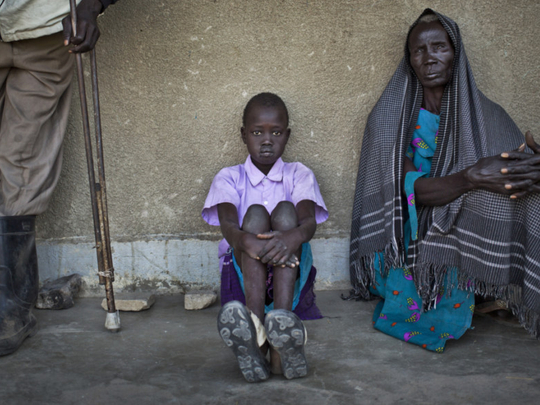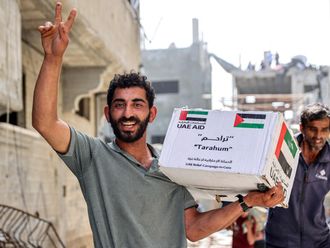
The swamp is so large it can be seen from space. During the rainy season, it stretches over an area the size of France, a forbidding maze of reeds and crocodiles that long warded off even the most intrepid of explorers searching for the source of the Nile, whose waters flood these clay plains.
At night, swarms of ferocious mosquitoes seek out flesh. There are also tsetse and razor flies, and a variety of deadly snakes, not to mention the stifling humidity.
This vast marshland, known as the Sudd, is also home to something else: tens of thousands of desperate civilians who have fled South Sudan’s civil war, the subject of a “New York Times” virtual reality film about children, resilience and survival.
Geng Keah Deng, 50, was shot and bleeding when he left his village near the city of Leer this summer and waded into the swamp. “We would swim until we could swim no more,” he said. “We would eat water lilies, if we ate at all.”
He knew these waters, and he knew the dangers they posed. Yet he also knew that staying home was not possible.
“The intention of those fighting was not just to go after people with guns, but to go after civilians,” Deng said days after reaching the relative safety of an island in the swamp that, for the moment, was out of the reach of soldiers. He joined 80,000 others on this island alone. “They came to kill and they came to look for young girls,” he said of the fighters who came to his village.
Deng has five daughters. He watched as one was carried away by fighters after he was shot. He does not know what has become of the other four.
“We don’t know whether they were killed or whether they were taken as wives,” he said.
Four years after South Sudan achieved independence from Sudan to become the world’s newest nation, the country has been torn apart.
A power struggle between President Salva Kiir and his Vice-President, Riek Machar, quickly devolved into a civil war pitting the nation’s largest ethnic groups against one another. The conflict ranks among the most devastating on the planet, with 4.4 million people facing the threat of starvation and 2.2 million forced from their homes.
A report released in October by a commission formed by the African Union — delayed for months out of fear that it would inflame tensions and complicate efforts to broker peace — offered further evidence that atrocities have been committed by all sides in the conflict.
“While conflict is not a new phenomenon to South Sudan, the majority of those the commission met with said that they have never seen the scale and nature of violations witnessed during this conflict,” the report says. “What makes it so much worse for them is the targeting of civilians, which they claim was never a central part of previous conflict.”
Investigators found evidence of rape used as a weapon of war, the recruitment of child soldiers and a level of cruelty that will make stitching this country back together a daunting task.
“I have seen people being forced to eat other humans,” one person in a United Nations camp told investigators. “Soldiers kill one of you and ask the other to eat the dead one.”
This summer, “The Times” set out to profile a child caught up in the struggle as part of a project to document how conflicts around the world invariably have an impact on the most innocent.
A 9-year-old boy named Chuol, who lived in a village near Leer, told a harrowing story of his father and grandfather being forced into a hut and burnt alive the night the fighters swept in.
Their screams could be heard as the rest of the family fled into the swamps. He lost contact with his mother in the chaos. His grandmother recalled the terror in vivid detail.
“There was an old man who could not run,” she said. “The soldiers called to him by name. They told him to open his mouth. One boy put an AK-47 in his mouth and killed him.”
As the surviving members of the family made their way through the swamp, what little sleep Chuol found as he clung to reeds or a patch of dry land was warped by nightmares.
Even when the family found temporary sanctuary on a small island, he did not speak for days.
“The situation of that particular child is unfortunately very typical,” said Jonathan Veitch, the Unicef representative in South Sudan.
There are about 850,000 children who have been displaced from their homes. An untold number of girls have been abducted, Veitch said, and at least 16,000 boys have been recruited to serve as soldiers by the two sides.
A peace deal signed in August called for child soldiers to be released from service, but Veitch said that neither of the sides had taken any steps to make that happen. “Both sides continue to deny even using child soldiers,” he said.
In August, when US President Barack Obama visited Africa, he made brokering peace a central focus of his trip. That pressure helped bring the warring parties together to reach a tentative ceasefire.
However, there continue to be reports of violations and fighting. Not far from where Chuol sought safety, witnesses have reported continuing clashes.
In recent weeks, witnesses have reported a mass grave in Leer filled with people killed on October 24. Separately, there are multiple reports of militias raiding nearby villages and abducting women and girls.
Doctors Without Borders has once again been forced to suspend operations in Leer after its facilities were looted and staff members were threatened.
“Violence against the civilian population is escalating,” said Tara Newell, the organisation’s emergency manager. “The civilian population is being subjected to repeated and targeted violence.”
As the reports of atrocities mount, there is fear that even the fragile peace process will completely collapse.
“Hardline elements on both sides didn’t want a deal, perceiving the war as a winner-take-all affair,” said John Prendergast, a rights activist who has worked on issues related to Sudan and South Sudan for three decades. He said that both sides — through violence and policy — continue to undermine any hope of a sustainable peace.
“As long as there is no cost to the perpetrators, the status quo will stand,” he said. One possible source of leverage, he said, would be seizing the assets of the leaders fuelling the conflict, much of which has been invested outside the country.
Even as fighting continued in some parts of the country, negotiators said that they had established a security framework that would allow for a transitional government — with Kiir remaining as President and Machar back in his post as Vice-President.
While observers said it was a hopeful sign, the fighting has generated blood feuds that will be hard to quell, and the battle lines grow more complicated the longer the war goes on.
The nation’s two largest ethnic groups — the Dinka, aligned with the government; and the Nuer, aligned with the rebels — have been at war since the conflict began. The nation’s third-largest group, the Shilluk, were initially aligned with the government but this spring switched to join the rebels.
In the area around Leer, a subset of the Nuer — the Bull Nuer — formed an alliance with the government when its commanders became disillusioned with the rebel leadership. By many accounts, Bull Nuer militias have committed some of the worst atrocities in the region.
Deng, the man who was shot and whose daughters were abducted, said peace was hard to imagine when all he had known was war.
“When the last war ended, we had high hopes, but those hopes have turned to a bloody disaster,” he said. “We have been told about peace, but how can we believe that when our women and children are missing. When we cannot eat. For us to live together again? I don’t know how we can forgive our enemies.”
–New York Times News Service












